Laysan albatross
| Laysan albatross | |
|---|---|
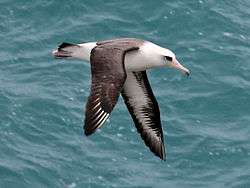 | |
| At Kilauea Point on Kauai, Hawaii | |
| Scientific classification | |
| Kingdom: | Animalia |
| Phylum: | Chordata |
| Class: | Aves |
| Order: | Procellariiformes |
| Family: | Diomedeidae |
| Genus: | Phoebastria |
| Species: | P. immutabilis |
| Binomial name | |
| Phoebastria immutabilis (Rothschild, 1893)[2] | |
| Synonyms | |
|
Diomedea immutabilis | |
The Laysan albatross (Phoebastria immutabilis) is a large seabird that ranges across the North Pacific. The Northwestern Hawaiian Islands are home to 99.7% of the population. This small (for its family) gull-like albatross is the second most common seabird in the Hawaiian Islands, with an estimated population of 2.5 million birds, and is currently expanding (or possibly re-expanding) its range to new islands. The Laysan albatross was first described as Diomedea immutabilis by Lionel Walter Rothschild, in 1893, on the basis of a specimen from Laysan Island.[3]
Etymology
It is named for Laysan, one of its breeding colonies in the Northwestern Hawaiian Islands.
Description
The Laysan albatross averages 81 cm (32 in) in length[4] and has a wingspan of 195 to 203 cm (77–80 in).[5] Males, which weigh 2.4 to 4.1 kg (5.3–9.0 lb), are larger than females, which weigh 1.9 to 3.6 kg (4.2–7.9 lb).[6][7] This albatross has blackish-gray upperwing, mantle, back, upper rump, and tail, and its head, lower rump, and underparts are white. It has a black smudge around the eye, and its underwing pattern varies between individuals, with some having narrower black margins and variable amounts of black in the underwing coverts. Finally, the bill is pink with a dark tip. Juveniles have a gray bill and a dark upper rump.[4] This species does not have a breeding plumage.[6]
The Laysan albatross is usually easy to identify. In the North Pacific, it is simple to separate from the other relatively common albatross, the all black black-footed albatross. It can be distinguished from the very rare short-tailed albatross by its all-dark back and smaller size. The Laysan albatross's plumage has been compared to that of a gull, two-toned with a dark gray mantle and wings and a white underside and head.
Distribution and habitat
The Laysan albatross has a wide range across the North Pacific, with 16 nesting sites. All but 0.3% of the breeding population is found among the Northwestern Hawaiian Islands, particularly the islands of Midway and Laysan. Small populations are found on the Bonin Islands near Japan and the French Frigate Shoals, and the bird has begun to colonize islands off Mexico, such as Guadalupe Island[4] and others in the Revillagigedo Archipelago.[5] When away from the breeding areas, they range widely from Japan to the Bering Sea and south to 15°N.[4]
Behavior
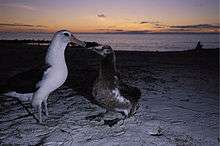
The Laysan albatross is normally a silent bird, but on occasion they may be observed emitting long "moo"-ing sounds, descending whinnies, or rattles.[6] Female Laysan albatrosses may bond for life and cooperatively raise their young.[8]
A female Laysan albatross named Wisdom is the oldest known wild bird in the United States or the Northern Hemisphere. Wisdom was banded by a U.S. Geological Survey researcher in 1956, and in February 2014 she was seen rearing a new chick on Midway Atoll. Because Laysan albatrosses can't breed until they are five years old, as of 2014 Wisdom was estimated to be at least 63 years old.[9][10]
Reproduction
The Laysan albatross is colonial, nesting on scattered small islands and atolls, often in huge numbers, and builds different styles of nests depending on the surroundings, ranging from simple scoops in the sand[11] to nests using vegetation.[4] Laysan albatrosses have a protracted breeding cycle. They breed annually, although some birds skip years.[4] Juvenile birds return to the colony three years after fledging, but do not mate for the first time until seven or eight years old. During these four or five years they form pair bonds with a mate that they will keep for life. Courtship entails especially elaborate 'dances' that have up to 25 ritualized movements.
Occasionally the birds form same-sex pairs consisting of two females. This has been observed in the colony on the Hawaiian island Oahu, where the sex ratio of male to female is 2 to 3 and 31% of all pairs are between females. Paired females can successfully breed when their eggs are fertilized by males. [12] This phenomenon has been useful to conservation efforts in the Hawaiian Islands, where researchers have successfully swapped unfertilized eggs from female-female pairs with fertile eggs translocated from pairs nesting on military airfields and in other unsafe nesting areas. The female-female pairs then hatch and raise the foster-chicks. [13]
The single egg is buff-white[11] and may have spots.[14] Both birds incubate the egg; the male does so first. Incubation takes about 65 days, and is followed by several weeks of brooding, after which both parents are out at sea to provide for the growing chick. The chick takes about 160 days to fledge. This time investment by the parents may explain the long courtship; both parents want to be sure the other is serious. The chicks are fed regurgitated meals of very rich "stomach oil" and partially digested squid and fish by the parents.
The Laysan albatross and the black-footed albatross have been known to hybridize.[5][6] Like all albatrosses, the Laysan albatross is known to be a long-living bird. The oldest known live bird, a female named Wisdom, is at least 64 years old.[15] In 2014 she hatched a healthy chick which is believed to be her 36th.[16][17] The longest lifespan confirmed for a wild seabird was for a breeding male Laysan that was found to have been banded 53 years previously. Other albatross are thought to match or maybe even exceed this record but few confirmations of very old albatross exist.[18]
Feeding
The Laysan albatross feeds predominantly on cephalopods,[19] but will also eat fish, crustaceans, and other invertebrates.[20]
Conservation
| Breeding location | Breeding pairs | Trend |
|---|---|---|
| Midway Atoll | 441,178 | Stable from 1992 to 2005 |
| Laysan Island | 103,689 | Stable from 1992 to 2005 |
| French Frigate Shoals | Stable from 1992 to 2005 | |
| Other northwestern Hawaiian Islands | ||
| Tori-shima (Izu Islands) | 1,218 | Unknown |
| Bonin Islands | 23 | Unknown |
| Islas Guadalupe | 337 | Increasing |
| Other offshore Mexican islands | 63 | Increasing |
| Total | 590,926 | −30 to 49% over 85 years |
The IUCN has classified the Laysan albatross as vulnerable due to drastic reductions in populations; however recent studies show that the population may be rebounding.[1] The IUCN now classifies the Laysan Albatross as Near-threatened. The Laysan albatross, while a common species, has not yet recovered from the wide-scale hunting of the early 1900s,[4] with feather hunters killing many hundreds of thousands and wiping them out from Wake Island and Johnston Atoll.[21] This slaughter led to efforts to protect the species (and others) which led eventually to the protection of the Northwestern Hawaiian Islands.[22] The species is still vulnerable to longline fisheries and the ingestion of floating plastics due to high rates of plastic pollution. Feral cats are known to prey on nesting birds and chicks on some of the more newly colonized islands. In some places big headed ants are a threat to young albatross chicks.
The Laysan albatross has an occurrence range of 38,800,000 km2 (15,000,000 sq mi) and a breeding range of 3,500 km2 (1,400 sq mi) with a population of 1,180,000 mature birds estimated in 2006.[4] Midway Atoll, Laysan Island, and the French Frigate Shoals have more than 90% of the breeding pairs at 551,940.[23] Bonin Island has 23 pairs and offshore Mexico has about 400 pairs with 337 pairs on Isla Guadalupe.[24] The northwestern Hawaiian Islands have suffered a 32% reduction in breeders from 1992 to 2002.[25][26] However, the last three years has seen a rebound that stabilized the period between 1992 and 2005.[24] This species was extirpated from Wake Atoll, Johnston Atoll, and Minami Torishima. The Mexican population has been increasing since its inception.[4]
In the past, harvesting for feathers was a major threat, along with high seas drift nets; however both of these have ceased, barring some small-scale illegal drift net operations. Current threats today are the longline fisheries.
Midway Atoll
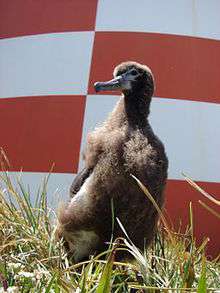

Lead poisoning is killing thousands of Laysan albatross each year on Midway Atoll, part of the Papahānaumokuākea Marine National Monument. The Laysan albatross has been globally listed as vulnerable to extinction by the World Conservation Union and is a special trust species on the Midway Atoll National Wildlife Refuge in the recently established National Monument.
"Laysan chicks raised in nests close to 90 buildings left behind by the Navy are ingesting lead-based paint chips. This is causing shockingly high lead concentrations in their blood, leading to severe neurological disorders, and eventual death," said George Fenwick, president of American Bird Conservancy. "Federal funds are urgently needed to clean up this toxic mess to protect the Laysan albatross as well as future visitors to the new Marine National Monument."[27] As many as 10,000 chicks, or five percent of hatched chicks, may be killed annually by exposure to lead-based paint. Many Laysan chicks that nest within five meters of building structures exhibit a condition referred to as "droopwing" which commonly manifests itself in the chicks’ inability to raise their wings and which thus drag on the ground, resulting in broken bones and open sores. Chicks with droopwing will never be able to fly and will die of starvation or dehydration. Other chicks in close proximity to buildings also suffer detrimental effects from lead exposure. These chicks have blood lead concentrations that cause immunological, neurological, and renal impairments, significantly decreasing their chances of survival.
The Department of the Interior (DOI) estimates that $22.9 million is needed to clean up the toxic lead paint on Midway Atoll. The 95 federally owned government buildings would need to be stripped of all lead-based paint and sand areas surrounding these old buildings thoroughly sifted to remove lead paint chips. When American Bird Conservancy staff presented the severity of this growing threat to an already imperiled bird species to DOI officials, they were told that the new Northwestern Hawaiian Islands Marine National Monument did not have any federal funds dedicated to its operation. Moreover, the DOI officials stated that the current federal budget for the nation’s wildlife refuge system would be insufficient to prevent the continued ingestion of lead paint by Laysan chicks.
Gallery
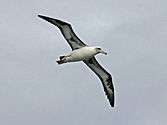 At Kilauea Point on Kauai, Hawaii
At Kilauea Point on Kauai, Hawaii At Kilauea Point on Kauai, Hawaii
At Kilauea Point on Kauai, Hawaii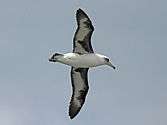 At Kilauea Point on Kauai, Hawaii
At Kilauea Point on Kauai, Hawaii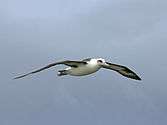 At Kilauea Point on Kauai, Hawaii
At Kilauea Point on Kauai, Hawaii
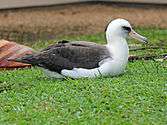 At Princeville, Hawaii
At Princeville, Hawaii
Footnotes
- 1 2 BirdLife International (2013). "Phoebastria immutabilis". IUCN Red List of Threatened Species. Version 2013.2. International Union for Conservation of Nature. Retrieved 26 November 2013.
- ↑ Brands, S. (2008)
- ↑ Robertson, C. J. R. (2003)
- 1 2 3 4 5 6 7 8 9 10 BirdLife International (2008)
- 1 2 3 Dunn, J. L. & Alderfer, J. (2006)
- 1 2 3 4 Floyd, Ted (2008)
- ↑ Dunning Jr., John B., ed. (1992). CRC Handbook of Avian Body Masses. CRC Press. ISBN 978-0-8493-4258-5.
- ↑ "Gay animals going at it like rabbits". The Register. 17 June 2009.
- ↑ Memott, Mark (6 February 2013). "Oh, Mama! World's 'Oldest' Bird Has Another Chick". NPR - The Two-Way. Retrieved 8 February 2013.
- ↑ "America's oldest wild bird is a new mom". CNN. 9 March 2011. Retrieved 9 March 2011.
The bird was first identified and banded by a USGS researcher in 1956 when she was incubating an egg, according to the USGS. As the Laysan albatross can't breed before age 5 – and spends much of its life before that at sea – scientists estimate Wisdom is at least 60 years old. She may be even older, though, as most Laysan albatrosses don't breed until age 8 or 9 after an extended courtship...
- 1 2 Udvardy, M.D.F. (1994)
- ↑ Young, Lindsay C.; Zaun, Brenda J.; VanderWerf, Eric A. (2008). "Successful same-sex pairing in Laysan albatross". Biology Letters. 4 (4): 323–325. doi:10.1098/rsbl.2008.0191.
- ↑ Young, L.C., VanderWerf, E.A., Granholm, C.A.T.H.Y., Osterlund, H., Steutermann, K. and Savre, T., 2014. Breeding performance of Laysan Albatrosses Phoebastria immutabilis in a foster parent program. Mar Ornithol, 42, pp.99-103.
- ↑ Peterson, Roger Troy (1961)
- ↑ Crilly, Rob (2015-12-01). "World's oldest wild bird returns to shore to lay egg at age of 64". The Daily Telegraph. Telegraph Media Group Limited. Retrieved 2015-12-01.
- ↑ Dell'Amore, Christine (21 February 2013). "Oldest Known Wild Bird Hatches Chick at 62". National Geographic Daily News. Retrieved 3 March 2013.
- ↑ Heimbuch, Jaymi. "At 63 years old, Wisdom the Laysan albatross hatches another chick". Retrieved 6 February 2014.
- ↑ Wood, Gerald (1983). The Guinness Book of Animal Facts and Feats. ISBN 978-0-85112-235-9.
- ↑ Pittman, et al. (2004)
- ↑ Tickell (2000)
- ↑ Harrison (1990), p. 57
- ↑ Harrison (1990)(b), pp. 36–37
- ↑ Flint (2007)
- 1 2 Naughton, et al. (2007)
- ↑ Flint, B. (2003)
- ↑ Gilman & Freifeld (2003)
- ↑ Environmental News Service (12 December 2006)
References
- BirdLife International (2008). "Laysan Albatross - BirdLife Species Factsheet". Data Zone. Retrieved 22 Feb 2009.
- Brands, Sheila (14 August 2008). "Systema Naturae 2000 / Classification - Diomedea subg. Phoebastria -". Project: The Taxonomicon. Retrieved 22 February 2009.
- del Hoyo, J.; Elliot, A.; Sargatal, J., eds. (1992). Handbook of the Birds of the World. Volume One Ostrich to Ducks. ISBN 84-87334-10-5.
- Dunn, Jon L.; Alderfer, Jonathan (2006). "Albatrosses". In Levitt, Barbara. National Geographic Field Guide to the Birds of North America (fifth ed.). Washington D.C.: National Geographic Society. p. 78. ISBN 978-0-7922-5314-3.
- Environmental News Service (12 December 2006). "Lead Paint Killing Birds in New Marine National Monument". Environmental News Service. Retrieved 4 July 2009.
- Flint, E. (2007). Hawaiian Islands National Wildlife Refuge and Midway Atoll National Wildlife Refuge - annual nest counts through hatch year 2007.
- Floyd, Ted (2008). "Tubenoses: Albatrosses, Shearwaters & Petrels, and Storm-petrels". In Hess, Paul; Scott, George. Smithsonian Field Guide to the Birds of North America (First ed.). New York, NY: HarperCollins Publishers. p. 81. ISBN 978-0-06-112040-4.
- Gilman, E.; Freifeld, H. (2003). "Seabird mortality in North Pacific longline fisheries". Endangered Species Update (20): 35–46.
- Harrison, Craig S. (1990). Seabirds of Hawaii. Cornell University Press. ISBN 0-8014-9722-1.
- Naughton, M.B.; Romano, M.D.; Zimmerman, T.S. (2007). A Conservation Action Plan for Black-footed Albatross (Phoebastria nigripes) and Laysan Albatross (P. immutabilis) (1st ed.).
- Peterson, Roger T. (1961) [1941]. "Albatrosses: Diomedeidae". A Field Guide to Western Birds. Peterson Field Guides. 2 (Second ed.). Boston, MA: Houghton Mifflin. p. 8. ISBN 0-395-13692-X.
- Pitman, R.L.; Walker, W.A.; Everett, W.T.; Gallo-Reynoso, J.P. (2004). "Population status, foods and foraging of Laysan Albatrosses Phoebastria immutabilis nesting on Guadalupe Island, Mexico". Marine Ornithology (32): 159–165.
- Robertson, C.J.R. (2003). "Albatrosses (Diomedeidae)". In Hutchins, Michael; Jackson, Jerome A.; Bock, Walter J.; Olendorf, Donna. Grzimek's Animal Life Encyclopedia. 8 Birds I Tinamous and Ratites to Hoatzins. Joseph E. Trumpey, Chief Scientific Illustrator (2nd ed.). Farmington Hills, MI: Gale Group. pp. 113–122. ISBN 0-7876-5784-0.
- Tickell, W.L.N. (2000). Albatrosses. Robertsbridge, UK: Pica Press.
- Udvardy, Miklos, D.F.; Farrand Jr., John (1994) [1977]. "Species Account". In Locke, Edie. National Audubon Society Field Guide to North American Birds. National Audubon Field Guide Series. Birds (Western Region) (2nd ed.). New York, NY: Alfred A. Knopf. pp. 356–357. ISBN 0-679-42851-8.
- Waid, Robert, 2005 ed. The Majestic Albatross - Images of Kauai's Beloved Seabird
- Whittow, G. Causey (1993). Poole, A.; Gill, F., eds. Laysan Albatross (Diomedea immutabilis). The Birds of North America, No. 66. The Academy of Natural Sciences (Philadelphia); The American Ornithologists’ Union (Washington, D.C.).
External links
| Wikimedia Commons has media related to Phoebastria immutabilis. |
| Wikispecies has information related to: Phoebastria immutabilis |
- BirdLife species factsheet for Phoebastria immutabilis
- Photos of the Laysan Albatross at jostimages.com
- "Phoebastria immutabilis". Avibase.

- "Laysan albatross media". Internet Bird Collection.
- Laysan albatross photo gallery at VIREO (Drexel University)
- Interactive range map of Phoebastria immutabilis at IUCN Red List maps
- Audio recordings of Laysan albatross on Xeno-canto.
